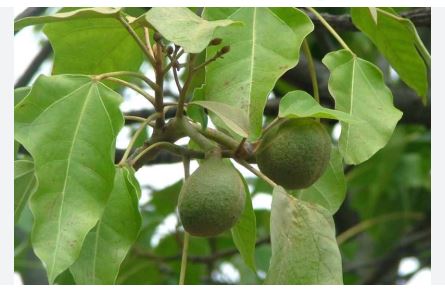
Aleutites moluccana, commonly known as Kukui or Candlenut, is part of the Aleutites genus in the Euphorbiaceae family, which includes a diverse range of plants like poinsettias and cassava. This species is notable for its large, lobed leaves and the production of nuts that are used for various purposes. The name “moluccana” indicates an origin from the Moluccas, though its true native area is a subject of some debate.
While traditionally considered native to the Moluccas (Maluku Islands) in Indonesia, Aleutites moluccana has spread across the Pacific and Southeast Asia through human activity, making it difficult to pinpoint an exact native region. Its naturalized range includes Hawaii, where it’s the state tree, Polynesia, parts of Southeast Asia, and even some Pacific islands, thriving in tropical and subtropical climates.
Kukui has a rich cultural history, especially in Polynesia, where it has been integral to the life of native peoples for centuries. In Hawaii, the kukui tree was brought by early Polynesian voyagers and used for numerous purposes: its oil was used for torches, its wood for canoes, its nuts for lei-making, and its leaves for healing. The name “Kukui” in Hawaiian means “light” or “torch,” reflecting its use in traditional lighting. Its nuts are also a source of food after processing to remove toxins, and the oil has medicinal uses. In other parts of Southeast Asia, it’s known for culinary uses, particularly in Indonesian and Malaysian cuisine, where the nuts are a key ingredient in dishes like curries. Its cultural significance extends to symbolism, often representing enlightenment or protection.
Kukui is adapted to USDA Hardiness Zones 10 through 12, requiring warm, tropical to subtropical environments to thrive. In these zones, it can grow into a large tree, reaching heights of up to 60 feet. Its lifespan can be quite long, often exceeding 100 years when grown in ideal conditions, contributing to landscapes both as an ornamental and functional tree.
Kukui (Candlenut) (Aleurites moluccana): Characteristics
- Growth Habit: Grows as an evergreen tree, capable of reaching up to 60 feet in height with a broad, spreading canopy. It often has a somewhat irregular shape with multiple trunks or branches emerging from near the base.
- Leaves: Features large, heart-shaped or lobed leaves that are glossy, dark green on top and lighter underneath. Leaves can grow up to 12 inches long, providing dense shade and visual appeal.
- Flowers: Produces clusters of small, white to cream-colored flowers with a sweet scent. These flowers are unisexual, with male and female flowers on the same tree, blooming in spring.
- Fruit/Nuts: Bears round, green fruits that mature to a brown, woody capsule, each containing one to three seeds (nuts). These nuts are the source of candlenut oil and are known for their toxicity if not properly prepared.
- Bark: Has a bark that is initially smooth and gray, becoming more fissured and rough with age, adding to the tree’s ornamental value.
- Root System: Develops a robust root system, which can be quite extensive, aiding in soil stabilization but requiring consideration for planting near structures.
- Adaptability: Thrives in humid, tropical to subtropical climates with well-drained, fertile soils but can adapt to various soil types, provided there’s adequate moisture.
- Pollinator Attraction: Attracts bees and other pollinators, contributing to local biodiversity. The flowers provide nectar, and the tree supports various insects and birds.
- Cultural Uses: Historically used for lighting (hence “candlenut”), as the nuts could be strung together and lit like candles. Also used in cuisine, medicine, and for crafting in Polynesian cultures.
- Toxicity: Contains toxins in its raw nuts that require careful preparation (boiling or roasting) to be safely consumed by humans. The oil from the nuts has been used for both culinary and medicinal purposes.
Kukui (Candlenut) (Aleurites moluccana ): Cultivation
Site Selection
Choose a site with full sun to partial shade in a tropical or subtropical climate. Kukui prefers locations with high humidity and warmth.
Soil Preparation
Requires well-drained, fertile soil rich in organic matter. Amend heavy or sandy soils with compost or well-rotted manure to improve fertility and drainage.
Planting
Plant in spring or early summer. Dig a hole twice as wide as the root ball but no deeper, ensuring the root crown is level with the ground. Space trees at least 20 to 30 feet apart due to their mature size.
Watering
Water regularly to establish, keeping soil consistently moist but not waterlogged. Once established, Kukui is relatively drought-tolerant but thrives with regular watering in dry periods.
Mulching
Use organic mulch around the base to retain soil moisture, suppress weeds, and enrich the soil as it decomposes. Keep mulch away from the trunk to prevent rot.
Fertilization
Fertilize with a balanced, slow-release fertilizer in early spring. If growth is vigorous, additional fertilization might not be necessary, but if growth is slow, supplement with additional nutrients.
Pruning and Maintenance
Prune to shape or remove dead wood in late winter or early spring before new growth begins. Control the tree’s size if desired, but be aware of its potential to reach large sizes.
Pest and Disease Management
Generally resistant to pests, but watch for scale insects or fungal diseases in overly wet conditions. Ensure good air circulation and avoid overwatering to reduce disease risk.
Propagation
Propagate by seeds, which need to be scarified or soaked to germinate, or by cuttings from young branches. Seeds can be directly sown or started in pots for later transplantation.
Winter Care
In USDA Zones 10-12, no special winter care is needed as it’s adapted to warm climates. However, in the coolest parts of its range, protect young trees from occasional cold snaps with mulch or cloth covers.